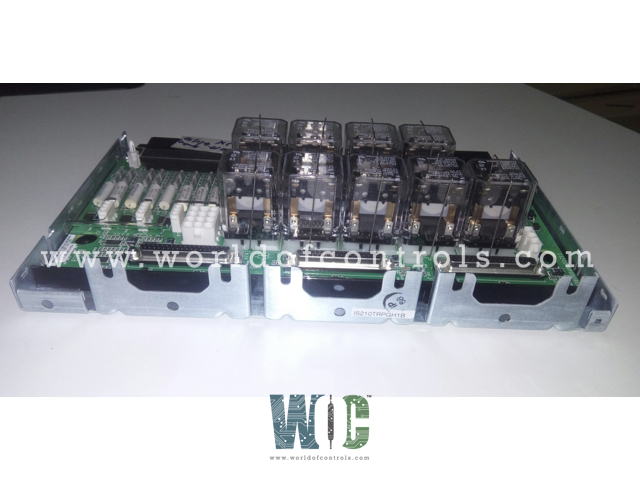
World Of Controls understands the criticality of your requirement and works towards reducing the lead time as much as possible.
IS210TRPGH1B - Gas Turbine Primary Trip Terminal Board is available in stock which ships the same day.
IS210TRPGH1B - Gas Turbine Primary Trip Terminal Board comes in UNUSED as well as REBUILT condition.
To avail our best deals for IS210TRPGH1B - Gas Turbine Primary Trip Terminal Board, contact us and we will get back to you within 24 hours.
SPECIFICATIONS:
Part Number: IS210TRPGH1B
Manufacturer: General Electric
Series: Mark VIe
Product Type: Primary Trip Terminal Board
Trip Solenoids: 3
Solenoid Rated Voltage/Current: 125 V dc
Solenoid Response Time: L/R time
Current Suppression: Metal oxide varistor
Control Relay Coil Voltage Supply: 28 V
Flame Detector Supply Voltage/Current: 335 V dc
Flame Detectors: 8
Availability: In Stock
Country of Origin: United States
Manual: GEH-6721J
DESCRIPTION:
IS210TRPGH1B is a Gas Turbine Primary Trip Terminal Board manufactured and designed by General Electric as part of the Mark VIe Series used in GE Distributed Control Systems. The TRPG terminal board is controlled by the I/O controller. TRPG contains nine magnetic relays in three voting circuits to interface with three trip solenoids, known as Electrical Trip Devices (ETD). The TRPG works in conjunction with the TREG to form the primary and emergency sides of the interface to the ETDs. TRPG also accommodates inputs from eight Geiger Mueller flame detectors for gas turbine applications. The H1A version for TMR applications has three voting relays per trip solenoid. The H1A and H1B versions include three voting relays built into each trip solenoid for TMR applications. The PTUR packs on TTURH1C control TRPG in Mark VIe systems. The D-type connectors on TTURH1C, which is connected to TRPG, accept the I/O packs as an input. Systems using simplex and TMR are both supported.
INSTALLATION:
The flame detectors (if utilized) are attached directly to the second terminal block, while the three trip solenoids are wired to the first I/O terminal block. The flame detectors are linked with power to J3, J4, and J5. J1 receives 125 V dc power for the trip solenoids, and J2 supplies power to the TREG board.
OPERATION:
The main protection solenoids are tripped by the main protection relays on TRPG, which are controlled by the I/O board. In TMR applications, a relay ladder logic two-out-of-three voting circuit is used to vote the three inputs in hardware. The I/O board keeps track of supply voltages for diagnostic purposes and tracks the current flow in its relay driver control line to determine whether to electrify or de-electrify the relay coil contact status. The diagnostics check each normally closed contact from a relay on the TRPG board to make sure it is functioning properly.
The controller transmits the primary overspeed trip, which is subsequently transmitted to the I/O pack or board and finally to the TRPG terminal board. Together with the TREG board, which is managed by the VPRO emergency overspeed system, TRPG functions. The TRPG/TREG combination may drive three ETDs.
WOC has the largest stock of GE Distributed Control System Replacement Parts. We can also repair your faulty boards. We can also supply unused and rebuilt backed-up with a warranty. Our team of experts is available round the clock to support your OEM needs. Our team of experts at WOC is happy to assist you with any of your automation requirements. For pricing and availability on any parts and repairs, kindly get in touch with our team by phone or email.
What is the Gas Turbine Primary Trip Terminal Board?
The GTPTTB is an essential component in a gas turbine control system. It serves as a terminal board where primary trip signals from various protective devices are received and processed to initiate turbine shutdown when necessary.
What is the purpose of the Gas Turbine Primary Trip Terminal Board?
The primary purpose of the GTPTTB is to receive and consolidate critical trip signals from protective devices like temperature sensors, pressure switches, or vibration monitors. These signals are used to ensure the safe shutdown of the gas turbine in case of abnormal operating conditions.
What happens during a turbine trip initiated by the GTPTTB?
When the GTPTTB receives a critical trip signal, it communicates this to the turbine control system, which then initiates a shutdown sequence. This sequence typically involves closing fuel supply valves, activating turbine brakes, and shutting down auxiliary systems to ensure safe turbine shutdown.